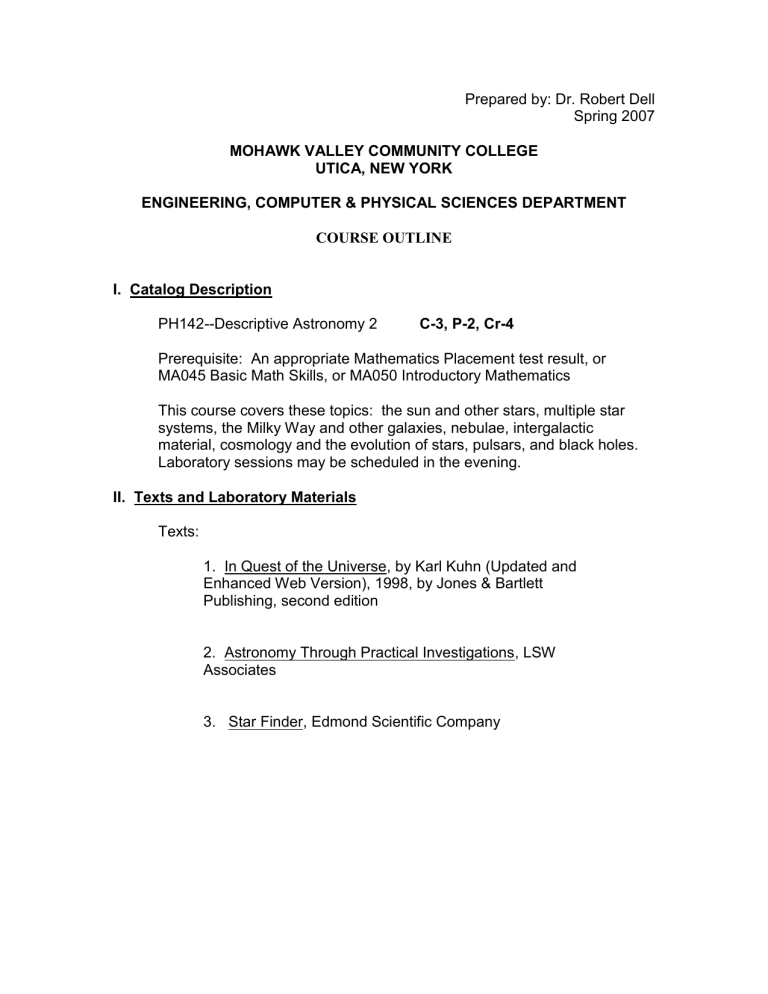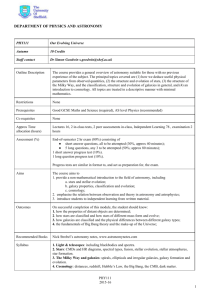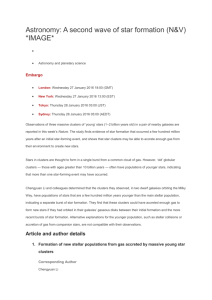PH142

Prepared by: Dr. Robert Dell
Spring 2007
MOHAWK VALLEY COMMUNITY COLLEGE
UTICA, NEW YORK
ENGINEERING, COMPUTER & PHYSICAL SCIENCES DEPARTMENT
COURSE OUTLINE
I. Catalog Description
PH142--Descriptive Astronomy 2 C-3, P-2, Cr-4
Prerequisite: An appropriate Mathematics Placement test result, or
MA045 Basic Math Skills, or MA050 Introductory Mathematics
This course covers these topics: the sun and other stars, multiple star systems, the Milky Way and other galaxies, nebulae, intergalactic material, cosmology and the evolution of stars, pulsars, and black holes.
Laboratory sessions may be scheduled in the evening.
II. Texts and Laboratory Materials
Texts:
1. In Quest of the Universe, by Karl Kuhn (Updated and
Enhanced Web Version), 1998, by Jones & Bartlett
Publishing, second edition
2. Astronomy Through Practical Investigations, LSW
Associates
3. Star Finder, Edmond Scientific Company
- 2 -
III. Student Objectives
The purpose of this course is to give a student a full introductory coverage of astronomy, to provide a means of scientific explanation for new astronomical discoveries and theories, and to put into practice techniques learned in Descriptive Astronomy 1.
At the conclusion of the course, the students will be able to:
1. Describe the physical nature of the Sun.
2. Describe the physical processes on the Sun.
3. Explain the sequence of events during a solar eclipse--partial, annular, total.
4. Demonstrate an understanding of the methods of distance measurement in astronomy such as triangulation, parallax.
5. Classify stars according to their magnitude and temperature.
6. Relate information provided by Hertzsprung-Russell diagram in order to determine distance to stars and clusters.
7. Differentiate among optical, visual, spectroscopic and astrometric binaries.
8. Determine the masses of stars from the Mass-Absolute Magnitude
Relationship or from the binary system relationship.
9. Contrast the R R Lyrae, Cepheids, novas, supernovas, T Tauri and irregular variables.
10. Discuss the Sunspot cycle
11. Describe and contrast galactic clusters, globular clusters, X-ray bursters.
12. Relate the various types of variable stars to stellar evolution.
13. Provide examples of the atoms and molecules existing in the interstellar medium.
14. Sketch the life cycle of several stars.
15. Describe the Milky Way and our position and motion in it.
16. Contrast the various types of galaxies.
17. Define "the Local Group".
18. Describe and contrast the theories of cosmology-big bang, steady state, oscillatory.
19. Describe a quasar, neutron star, black dwarf, and black hole.
20. Detail the dying process in an old star of various solar masses.
IV. General Topical Outline
1. Our Star--The Sun
A. Composition
B. Temperature
1. Surface
2. Interior
3. Color
C. Motions
D. Layers
1. Photosphere
2. Chromosphere
3. Corona
E. Phenomena
1. Photosphere
2. Sunspots
3. Spicules
4. Prominence
5. Flares
F. Solar Rotation
1. Measurement
2. Variableness
G. Eclipses
1. Total
2. Partial
3. Annular
2. Survey of Space
A. Distance
1. Triangulation
2. Light year
3. Astronomical Unit
4. Parsec
B. Motions of Stars
1. Proper Motion
2. Radial Velocity
3. Tangential Velocity
4. Space Velocity
C. Stellar Magnitudes
1. Apparent
2. Absolute
D. Colors of Stars
1. Apparent
2. Spectra a. Classes b. Temperature
E. Multiple Star Systems
1. Binaries a. Barnard's Star
2. Higher Order
F. Unusual Stars
1. Variable
2. Novae
3. Extended Atmosphere
4. X-rays
5. Pulsars
3. General Stars
A. Brightest
B. Nearest
C. Hertzsprung-Russell Diagram
4. Milky Way Galaxy
A. Description
1. Distribution of Stars
2. Our Position
3. Size
4. Rotation
B. Interstellar Medium
1. Cosmic Gas
2. Cosmic Dust
3. Nebulae
5. Stellar Evolution
A. Stellar Energy
1. Equilibrium
2. Processes a. Thermal--gravitation b. Nuclear
B. Stages
1. Protostar
2. Main Sequence
3. Giant
4. White Dwarf
5. End a. Black Dwarf b. Neutron Star c. Black Hole
6. Galaxies
A. Existence
B. Location
1. Distance
2. Distribution
C. Properties
1. Size
2. Mass
D. Types
1. Spiral a. Regular b. Barred
2. Elliptical
3. Irregular
E. Clusters
F. Quasars
7. Cosmology
A. Coverage
1. Origin
2. Evolution
3. Content
4. Organization
B. Expanding Universe
1. Law of Redshifts
2. Tired Light]
C. Models
1. Cosmological Principle
2. Types a. Steady State b. Big Bang c. Pulsating
8. Future of Astronomy
V. Laboratory Topics may include but not be limited to the following areas:
1. Introduction to Laboratory
2. Spectra of Gases
3. Variable Stars
4. Eclipsing Binaries
5. Material Between Stars
6. H-R Diagram and Stellar Life Cycles
7. Expansion of the Universe or Evening Observation
8. Classification of Galaxies
9. Solar Observation
10. Cosmology
11. Brightness of Stars
12. Stellar Parallax
13. Stellar Velocities
14. Our Star, The Sun









